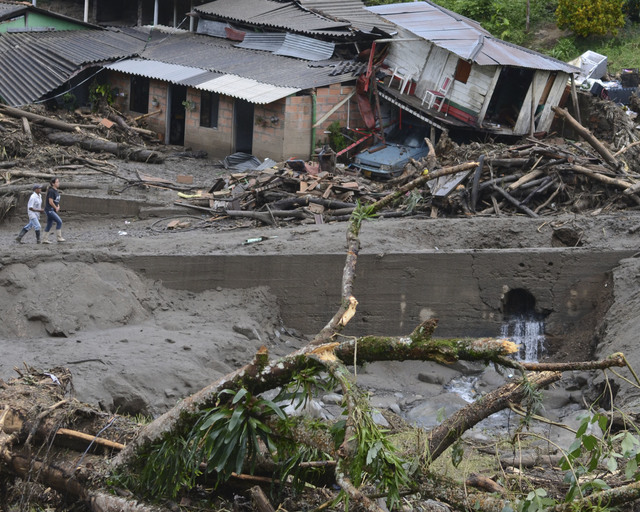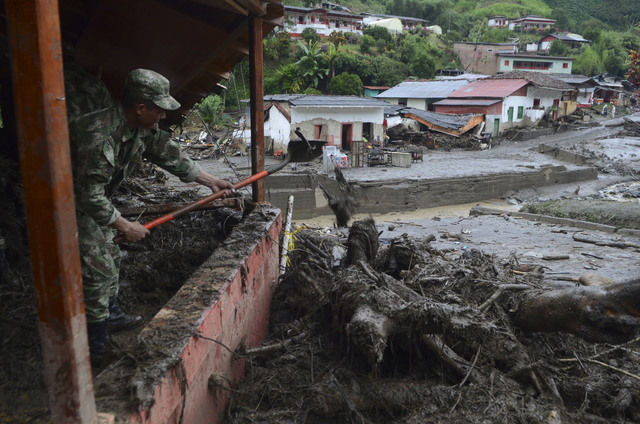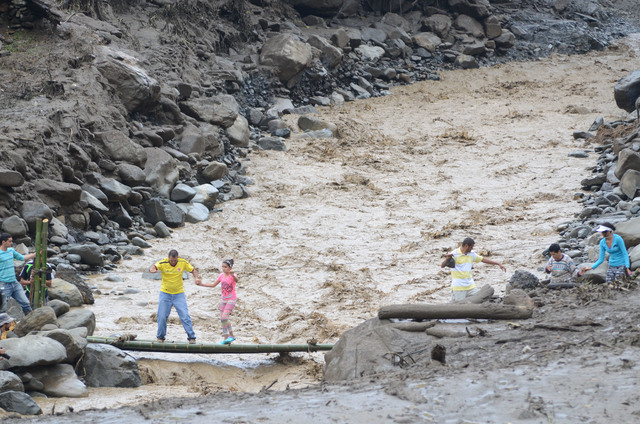SALGAR, Colombia — Hector Raul Henao weeps as he surveys the barren landscape of mud and uprooted trees that for years was a vibrant community of small coffee farmers. Off in the distance, across the still raging La Libordiana ravine,
SALGAR, Colombia — Hector Raul Henao weeps as he surveys the barren landscape of mud and uprooted trees that for years was a vibrant community of small coffee farmers. Off in the distance, across the still raging La Libordiana ravine, he points to the zinc-roofed house he fled — one of just two left standing in an area devastated by a pre-dawn mudslide the killed at least 65 people.
“I lost half my life,” he said Tuesday amid tears. When the earth rumbled, his 20-year-old son and two-month-old granddaughter were asleep at another house directly in the flash flood’s path. Both were killed along with several neighbors, many of whose bodies he says are still trapped in the mud.
“I wish I had been the one killed but God willed it this way,” said Henao, who survived along with his wife by forcing open a door against a raging current and fleeing to the jungled mountain rising directly from their home.
As the small mountain town of Salgar began digging out after Monday’s devastation, the tales of human tragedy multiplied. Survivors recalled being stirred from their beds by a loud rumble and neighbors’ shouts, barely having enough time to gather their loved ones.
The death toll, which authorities put at 65, was likely to grow as an undetermined number of people, perhaps as many as 100, remained unaccounted for. Authorities said they were too busy searching for bodies and assisting survivors at makeshift shelters to give a precise estimate of how many are missing.
Many of the dead are believed buried in the grey moonscape along with dozens of homes, bridges and even a grade school that locals say is where former President Alvaro Uribe studied as a child growing up in his mother’s hometown.
President Juan Manuel Santos, who traveled to the town to oversee relief efforts, said several children lost their parents and the bodies of those killed needed to be transported to Medellin, a three-hour drive, for identification. He vowed to rebuild the lost homes and provide shelter and assistance for the estimated 500 people affected by the calamity.
“Nobody can bring back the dead … but we have to handle this disaster as best we can to move forward,” Santos said.
Soldiers handed out food and blankets to the homeless on Tuesday as civil defense authorities armed with little more than shovels probed the shaky ground to look for bodies. Farmers like Henao were ordered to refrain from returning to their homes because of a risk of more landslides.
Sergio Fajardo, governor of Antioquia province, said that several cadavers had been deformed and dismembered, complicating the process of identification. The force of the flood had carried one body some 60 miles (100 kilometers ) downriver, he said.
Authorities asked heartbroken Colombians to refrain from sending physical donations and instead contribute to a fund to help families rebuild. For its part, the government has promised about $6,500 in economic assistance to those who suffered damage.
Colombia’s rugged topography, in a seismically active area at the northern edge of the Andes, combined with shoddy construction, has made the country one of Latin America’s most disaster-prone. More than 150 disasters have struck the country over the past 40 years, claiming more than 32,000 lives and affecting more than 12 million people, according to the Inter-American Development Bank.
The tragedy in Salgar appeared to be the single deadliest event since a 1999 earthquake in the city of Armenia that left hundreds dead. A wave of flooding during the 2011 rainy season left more than 100 dead over several weeks.
Authorities said they had no notion the town was at risk of a tragedy of such proportions. While flooding in the mountainous area is not uncommon, the heavy rains this time were dozens of miles (kilometers) uphill from the town, in a forested, sparsely populated area.
“It’s something you could never imagine,” said Henao, waiting to return home to salvage whatever possessions remain untouched by the flood. “When I heard the loud bang it seemed like the end of the world.”






